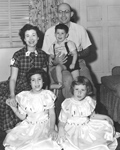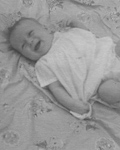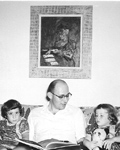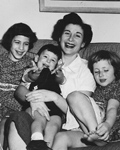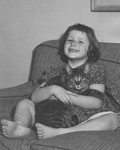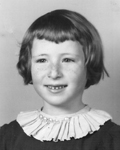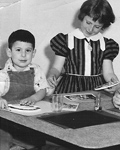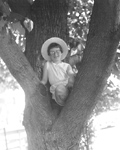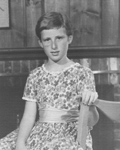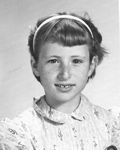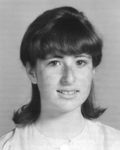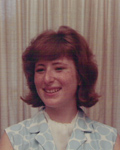Eve Kosofsky Sedgwick (1950-2009) was a poet, artist, literary critic and teacher. She is perhaps best known as one of the originators of Queer Theory. Her work and her example continue to have a significant effect in shaping the lives and thought of many people. Sedgwick had little wanderlust, but she had a strong desire to find or create places that would give her both the freedom and the support that she needed. Each of the places that she lived had a strong and complex character for her — sometimes attractive, sometimes not — and each helped to shape her life there. This brief biography follows her from place to place.
BETHESDA 1957 – 1967
ITHACA 1967 – 1971
NEW HAVEN 1971 – 1976
ITHACA AGAIN 1976 – 1978
CLINTON 1978 – 1981
BOSTON 1981 – 1984
AMHERST 1984 – 1988
DURHAM 1988 – 1997
NEW YORK 1998 – 2009
Dayton: 1950 to 1957
Eve Kosofsky was born on May 2, 1950, at Good Samaritan Hospital, in Dayton, Ohio. Her parents, Leon Kosofsky and Rita Goldstein Kosofsky, were both natives of Brooklyn, New York, and graduates of Brooklyn College. The only members of their respective families to live outside of New York City, they were among the relatively few Jews living in Dayton, where Leon worked at Wright-Patterson Air Force Base as a civilian photogrammetrist specializing in aerial reconnaissance. Eve was a middle child: her sister Nina was born in 1947; her brother David in 1953.
Eve attended public schools in Dayton for two years: kindergarten and second grade, skipping first grade due to her early mastery of reading and general intellectual precocity. She took ballet lessons, made paintings and drawings inspired by art reproductions her parents borrowed each month from the Dayton Museum of Art, and by the age of seven had decided that she would be a poet.
Bethesda: 1957 to 1967
In 1957 Leon Kosofsky was offered a position with the Army Map Service, doing the same sort of photogrammetric work as in Dayton. The salary and advancement possibilities were somewhat better, but the real lure was location: the relatively cosmopolitan Washington, D.C. area. So, when Eve was seven, the family moved to a house in Bethesda, Maryland, inside the not-yet-completed Beltway, where she spent the next decade of her life.
The move to Bethesda coincided with the launch of Sputnik and the start of the ‘Space Race’ between the U.S. and the U.S.S.R., leading directly to the establishment of NASA. For Leon, the transition from aerial reconnaissance to orbital photography was natural, and the opportunity to move from the military culture of the Army Map Service to the newly chartered civilian agency was irresistible. Joining NASA in the early sixties, he became Program Engineer for the Lunar Orbiter program of unmanned photographic satellites. Leon created maps of the moon to help locate places for manned missions to land, and aided in the photographic analysis of lunar geology. He reported the results of his work in a book, The Moon as Viewed by Lunar Orbiter, published by NASA in 1970.
In Bethesda, Eve attended Montgomery County public schools. At Wyngate Elementary School she continued to pursue her chosen vocation as a poet. Her essay “A poem is being written” (Tendencies, 1993) examines her development as a poet. It begins “This essay was written late: twenty-seven years late, to the extent that it represents a claim for respectful attention to the intellectual and artistic life of a nine-year-old child, Eve Kosofsky.” Indeed it was at that age, when she was in fifth grade, that Eve produced a small anthology of her poems, entitled “Exiles and Fugitives,” bound in a cover illustrated with her own drawing. Only a few of Eve’s poems from this period are known to have survived
From Wyngate, Eve went on to North Bethesda Junior High School and Walter Johnson High School. She served as poetry editor for her high school’s literary magazine, to which she also contributed several poems. Other extra-curricular activities included Forensics Club and Drama Club.
Through the former, she participated in inter-scholastic competitions, specializing in an event called ‘Extemporaneous Speaking,’ where competitors were required to give original, and largely spontaneous speeches on topics made known to them only shortly before. Her abundant creativity and verbal fluency carried her past the handicap of her natural shyness, and Eve excelled; the same process was evident in her teaching and public speaking throughout her career.
Although her Drama Club activities entailed relatively little actual performance in high-school productions, Eve’s involvement in theater during those years had an important influence on the development of her interests. Specifically, she took summer courses at the Washington Theater Club, at that time an organization with a commitment to the innovative staging of socially consequential plays in an intimate performance space: a converted carriage house in the Dupont Circle/Georgetown section of Washington. Within that milieu, Eve found herself drawn to a constellation of personal qualities and styles that she described at the time as ‘theatrical’. In retrospect, she would speak of her Washington Theater Club experience as a richly formative awakening of her awareness of, and attraction to, a gay sensibility.
During the Bethesda years, with her husband engaged in lunar exploration and her growing children requiring less of her energy, Rita Kosofsky pursued a career in a direction related to Eve’s developing interests. Building on her undergraduate degree in English, Rita took graduate courses at the University of Maryland, earning an M.A. in English Literature. Her master’s thesis was published as a book, Bernard Malamud: An Annotated Checklist, by Kent University Press in 1969.
While attending graduate school, Rita worked for the Montgomery County public schools as a non-teaching ‘lay reader’ grading high-school students’ English compositions. Eve often helped in this work, making corrections and suggesting improvements on essays and term papers written by students several years older. During her senior year at Walter Johnson, Eve won the National Council of Teachers of English award; that same year, Eve’s mother began her career as a high-school English teacher in another Montgomery County school. Recognized for her talent in teaching gifted students, Rita went on to design the curriculum for Honors English courses at Walt Whitman High School.
In the summer of 1966, following her junior year in high school, Eve attended a six-week summer program at Cornell University. The program was run by the Telluride Association, which also maintained a scholarship house for talented Cornell students. Following Eve’s summer program, she was offered a scholarship at Telluride House, which led to her entering Cornell in the fall of 1967.
Ithaca: 1967 to 1971
Telluride House was established in 1910 as an institution for men only. In the 1960s it was gradually making the transition to accepting women as well. During Eve’s first year at Cornell, undergraduate women were not yet allowed to sleep at Telluride House although they took their meals there and participated in all of the activities of the house. So Eve had a room in a Cornell dormitory. The following year she was permitted to stay at the house.
Applications to Telluride summer programs, and to Telluride House, were reviewed by students currently living in the house. One of these students was Hal Sedgwick, who thus first came to know Eve through her writing. In the fall of 1967 Hal entered graduate school at Cornell and moved out of Telluride House. He continued to spend time at the house, however, to visit Eve and his other friends there.
In the summer of 1969, following her sophomore year, Eve and Hal were married. For their remaining two years at Cornell, they lived in the attic of a farmhouse in the countryside near the town of Brooktondale, a few miles from Ithaca. The farmhouse belonged to Frank Rosenblatt, a Cornell professor whose work on “perceptrons” pioneered the early study of the computational abilities of neural networks. Rosenblatt rented the rooms in his house at nominal rates to an ever-shifting population of six or eight friends and students, and the house was run quasi-communally, with its residents taking turns making dinner for the whole group. After dinner everyone remained around the dinner table while Frank read to them another chapter or two from some book he had selected for their entertainment (The Wind in the Willows, The Once and Future King, Giles Goat-Boy, and so forth). The Brooktondale community was a formative model for Sedgwick’s conception of the non-nuclear, non-biological family, as Frank Rosenblatt was one of her models of the bachelor “uncle.”
At Cornell Sedgwick was accepted into a college-wide honors program that allowed her to shape her own course of study and to largely avoid the college’s distribution requirements. (What could not be avoided was the two-year physical education requirement, which Sedgwick satisfied by taking archery in the mild weather and ice skating in the cold weather, two activities in which she became highly proficient.) Sedgwick concentrated on English literature, taking many courses and seminars in that area. Most importantly, she took several seminars with Neil Hertz, who strongly influenced her thinking and became a lifelong friend. A year-long seminar in poetry writing with A. R. Ammons, whose poetry she admired, led to the writing of a substantial number of poems, many of which are still unpublished. Another important influence was Allan Bloom, a political philosopher and student of Leo Strauss. Sedgwick took several courses and seminars from Bloom, who had a close connection with Telluride House and drew a number of Sedgwick’s friends there into careers as Straussian political philosophers. Sedgwick discusses her fascination with Bloom in Epistemology of the Closet. Sedgwick also studied anthropology (with James Seigel), history of psychology (with Robert MacLeod), and diverse other courses such as mathematical logic. Sedgwick graduated summa cum laude from Cornell in June of 1971.
New Haven: 1971 to 1976
Eve Sedgwick entered the Ph.D. program in English at Yale in the fall of 1971. At the same time Hal Sedgwick began a post-doctoral fellowship in New York City and later took up a faculty position there. After a brief attempt at living with Hal in suburban Westchester county and commuting to New Haven, Eve found a room near the Yale campus in New Haven. This was the beginning of a long-distance, weekend relationship with Hal that continued for over twenty-six years.
Sedgwick was drawn to Yale by the strength of its reputation in literary theory, particularly the then-new theory of deconstruction. She studied with Paul de Man, Harold Bloom, Geoffrey Hartman, and J. Hillis Miller, among others. Yale graduate school was not a particularly happy experience for Sedgwick. She experienced the faculty as remote, and received little recognition of her abilities. Determined not to linger, she finished her graduate studies in four years, submitting a dissertation (The Coherence of Gothic Conventions) to a committee chaired by Miller.
Sedgwick was much happier with her fellow graduate students, forming sustaining, and lasting, friendships with Jonathan Kamholtz, Joseph Gordon, and several others, and continuing from Cornell her close friendships with Josh Wilner and Marsha Hill. She also continued to write and publish poetry during her years in New Haven.
The completion of her Ph.D. marked the beginning of Sedgwick’s long efforts to obtain a stable academic position. Over the following nine years Sedgwick submitted innumerable job applications. She once estimated that she had had over a hundred job interviews, almost all of which were unsuccessful. She remarked, however, that she had made many friends, even from the unsuccessful applications, and had learned a great deal about the process. She later wrote a pamphlet, published by the MLA, with advice for graduate students on the job market.
Failing to find a job, Sedgwick was given a one-year lectureship by Yale, and remained in New Haven for the 1975-76 academic year.
Ithaca again: 1976 to 78
In the fall of 1976 Sedgwick returned to Ithaca with a Mellon postdoctoral fellowship in English and creative writing at Cornell. While in Ithaca, Sedgwick continued to work on the subject of her dissertation, substantially revising its first chapter, and working on a new paper on “the character in the veil.”
She also published several poems in literary journals and completed the manuscript of a book of her poetry: Traceable, Salient, Thirsty…. After numerous efforts, however, and in spite of some positive reviews, she was unable to find a publisher for the book. Years later some of the poems from that manuscript appeared in Fat Art, Thin Art. Others remain unpublished.
While at Cornell, Sedgwick also engaged in an extended study of the poetry and other writing of James Merrill. This resulted in the paper “1001 Seances.”
Sedgwick was strongly attracted to Ithaca, and even after she had moved away she returned to live there for several summers.
Clinton: 1978 to 81
Sedgwick’s first faculty position was at Hamilton College in Clinton, New York.
Hamilton College, founded in 1812, was for men only until 1978. In 1968, Hamilton had participated in establishing Kirkland College as an adjacent, independent college for women. After ten years, financial difficulties forced Kirkland to accept a merger with Hamilton, which then became co-ed.
Although some of Kirkland’s faculty were retained in the merger, others were not. The response of the Hamilton English Department to its new responsibility of educating women was to hire several women faculty members on non-tenure track positions (two years, potentially renewable for two more years). It was in this marginalized position, Sedgwick later said, that she learned feminism. She and a number of other women faculty across several departments joined together, calling themselves Faculty for Women’s Concerns, to work toward improving the situation of women faculty and students at Hamilton. The group acted as a collective, refusing to identify either a leader or a spokesperson, and signing all of their communications to the college administration simply “Faculty for Women’s Concerns.” This disconcerting strategy may have contributed to the FWC’s success in winning substantial support for its projects from the administration. Sedgwick formed several deep and lasting friendships with members of the FWC, including Janet Halley, Nancy Rabinowitz, Elaine Hansen, and Elizabeth Potter.
While she was at Hamilton, Sedgwick published her revised dissertation. She also published her first major critical article, “The Character in the Veil: Imagery of the Surface in the Gothic Novel.” This article, which she had been writing during her Mellon fellowship, appeared in the prestigious Publications of the Modern Language Association. It succeeded in being accepted for publication, Sedgwick believed, because of the PMLA‘s newly adopted policy of sending out articles for review without identifying either the name or the institution of the author, thus hampering the operation of the ’old-boys’ club’ that had dominated its pages. Sedgwick continued to write and publish poetry, including “Sexual Hum” and the novella-length narrative poem “Trace at 46.” In 1978 she began work on a book-length poem, “The Warm Decembers,” that she was (as she wrote in her note to the poem) “to regard as current work” for the following decade.
Beyond her positive experiences with her friends in FWC, Sedgwick found little to attract her to Hamilton and was eager to get out of Clinton before her four-year term expired.
Boston: 1981 to 1984
In the fall of 1981, Sedgwick joined the English Department of Boston University as a tenure-track Assistant Professor.
The ‘tenure-track’ designation was only nominal, however. The decade prior to Sedgwick’s arrival at BU had been turbulent. A new right-wing president at BU had moved aggressively against more progressive faculty, leading to an unsuccessful faculty vote for his ouster and, in 1979, a faculty strike1 that succeeded in unionizing the faculty. The success was brief, however. The union was decertified the following year when the National Labor Relations Board decided, farcically in the case of BU, that faculty at private universities were included in management. By 1981, tenure at BU had become a political decision, made by the BU president, and it was clear to Sedgwick from the onset that she would never be tenured there.
Nevertheless, Sedgwick enjoyed her time at BU. Her department was congenial to her and she made good friends there, including Helen Vendler, a senior scholar and, at the time, recent president of the MLA, who also became an important supporter and mentor for Sedgwick.
While at BU, Sedgwick published her second major critical article “Homophobia, Misogyny, and Capital: The Example of Our Mutual Friend.” This article later became a chapter in Sedgwick’s book Between Men: English Literature and Male Homosocial Desire, much of which was drafted while Sedgwick was at BU. She also wrote poetry, especially continuing to work on “The Warm Decembers.”
In Boston Sedgwick joined with several other women, not all of whom were at BU, to form a George Eliot reading group, which rather quickly morphed into a feminist experimental writing collective. Needing a course number in order to have their writing xeroxed, they chose ID 450, which then became their name. ID 450 met regularly during the time that Sedgwick was in Boston, and has continued to meet, with a shifting membership, ever since. This group produced a number of life-long friendships for Sedgwick, including those with Carolyn Williams, Mary Campbell, Nancy Waring, and others.
In the fall of 1983 Sedgwick moved across the Charles River, from Boston to Cambridge, to Radcliffe College’s Bunting Institute, where she had received a one-year faculty fellowship to complete her work on Between Men.
While she was at the Bunting Institute, Sedgwick was offered a faculty position at Amherst College in Massachusetts. Nine years out of graduate school, with a substantial body of published poetry and critical writing, including one book published and another almost completed, Sedgwick was offered an associate professorship. Her tenuous and shifting footing in academia had become secure. She went to Amherst with tenure.
Amherst: 1984 to 1988
After over 150 years as an all-male college, Amherst had become co-educational in 1976. An increased sensitivity to women’s issues contributed to Amherst taking the dramatic step in 1984 of banning fraternities on the campus, converting the on-campus fraternities into alternative forms of student housing. Additionally, the academic field of women’s and gender studies had been growing throughout the 1970s. Sedgwick was hired to bring an increased presence of gender studies to the English department, and hiring her with tenure gave her a secure position from which to encourage further change at Amherst.
This she did. For example, early in her tenure at Amherst, when invited to speak at a student convocation, she gave a satirical talk titled “Sabrina doesn’t live here anymore” (later published in the Amherst magazine) using the tribulations of the campus’s bronze statue of a naked woman of that name to discuss the conflicting pressures and expectations of being a woman at Amherst. Later, invited to address the seniors, arrayed in their gowns at a commencement gathering, she began by expressing her pleasure at seeing them all in their purple dresses and then went on to encourage them to pay close attention to how it felt to be dressed, and positioned as they then were. Institutionally, Sedgwick worked hard to gain greater academic respectability and support for studies of gender and sexuality. She was instrumental in the establishment, in 1987, of a department of women’s and gender studies, in which she then held a joint appointment.
A highly regarded undergraduate liberal arts college, Amherst placed strong emphasis on teaching, and this was reflected in the interests and priorities of the English department. Preparing and teaching her courses placed heavy demands on Sedgwick’s time. Also, during her time there, the department offered a year-long introductory course in reading and writing, taught in small sections by all of the department faculty, but with a common syllabus. Discussing, revising, and reaching agreement on the contents of this syllabus was a major and time-consuming preoccupation of the department, which Sedgwick participated in energetically, successfully advocating, for example, for the first-time inclusion of the town’s local poet, Emily Dickinson, previously regarded as too minor to be included with the likes of Robert Frost, the town’s other local poet.
Sedgwick of course was not alone in working for change at Amherst. Her closest ally in this effort was Andrew Parker, who had helped to bring Sedgwick to Amherst. Other faculty friends included Cindy Patton, Margaret Hunt, Judith Frank, and Rhonda Cobham-Sander. In addition to her friends at Amherst, Sedgwick also formed close friendships at some of the nearby colleges in the Pioneer Valley, including Mary Russo and Dan Warner at Hampshire College, and Maud Ellmann, who was visiting at Smith College and then at Amherst.
Sedgwick’s arrival at Amherst nearly coincided with the publication of Between Men: English Literature and Male Homosocial Desire (1985). This publication sharply increased Sedgwick’s recognition within the academic community. She traveled frequently to other colleges, but now, rather than hunting for a job, she was being invited to share her latest work. By the time that Between Men was published, Sedgwick had already begun writing the essays that would form her next book, Epistemology of the Closet. In 1985, in what was for her a highly significant personal accomplishment, she was invited to speak at the English Institute. Her talk there—one of the essays for her book-in-progress—was “The Beast in the closet: James and the writing of homosexual panic,” which later received the Crompton Noll award in gay and lesbian criticism from the Modern Language Association.
Her time at Amherst marked a personally painful shift in the balance between Sedgwick’s critical writing and her poetry. While continuing to be richly productive, and increasingly acclaimed, as a critic, she was blocked as a poet. The Warm Decembers was a central project for her during her years at Amherst, but although she was deeply engaged in thinking about and sketching fragments of it, it proved, as she later wrote, “unable to be written.” In her note, in 1994, to the publication of the half-finished poem, she sees “quite precisely the 1984 line… [that]… was the last one destined to have been written out of a relatively seamless sense of the integrity and momentum of this writing process. Yet it took me three or four more years of a punishing incredulity to understand that this poem was not being written. In fact it was nine years… before I seemed to be able to write poetry of any kind.”
Although Sedgwick enjoyed living in the Pioneer Valley and valued teaching at Amherst and helping to bring important change to the college, finding time for her writing was a continuing concern. In the spring of 1987, she was invited to spend the semester at the Berkeley campus of the University of California as the Mrs. William Beckman visiting professor. This position freed her from teaching but required several lectures, thus giving her both the time and incentive to work on two chapters for her book. For the following academic year, 1987-88, Sedgwick applied for and received a Guggenheim fellowship, which gave her the time she needed to complete much of the remaining work on Epistemology.
The AIDS epidemic was already underway but only beginning to be widely recognized when Sedgwick came to Amherst. During her years there it became devastatingly central in the lives of those in and close to the gay community. Sedgwick’s concern with the epidemic, and with the virulent homophobia of most of the social and political responses to it, was deeply woven into her writing of Epistemology. Her connection with the epidemic became much more personal near the beginning of 1987, when she met and ultimately formed very close friendships with two gay men living with AIDS. The first of these was Michael Lynch, whom Sedgwick first met at the annual meeting of the MLA during the last week of 1986. Lynch was a gay activist, writer, poet, and teacher living in Toronto. Sedgwick celebrated her relationship with him during the last few years of his life in her talk “White Glasses,” later published as an essay in her book Tendencies. Then, during her stay in Berkeley in the spring of 1987, Sedgwick met and became friends with Gary Fisher, a graduate student at UC and immensely talented young writer, who confided to Sedgwick (and few others) that he had AIDS.
During the year of her Guggenheim, Sedgwick continued to explore ways of more permanently increasing her time for writing. It was this, rather than a wish to leave Amherst, that made her tentatively receptive to a feeler from Stanley Fish, who was then engaged in transforming the English department at Duke University. Following negotiations and a visit to Durham, in North Carolina, Sedgwick was persuaded. She accepted an offer of a full professorship at Duke.
Durham: 1988 to 1997
If Sedgwick’s move to Duke contributed to the impression that its English department was becoming a center for new developments in literary criticism, it also enhanced her reputation as a rising academic star. This in turn perhaps heightened the attention that was paid to Epistemology of the Closet when it appeared in 1990. Such attention was amply rewarded, and Epistemology rapidly became a central text in the emerging field of gay studies. It was awarded second place (“honorable mention”) for the MLA’s 1990 prize for “outstanding literary or linguistic study” (first place went to Fredric Jameson, a senior colleague of Sedgwick’s at Duke, also recruited by Fish). In 1992 Sedgwick became a distinguished professor at Duke, receiving the Newman Ivy White Chair.
The attention paid to Sedgwick’s work was far from being entirely favorable. Her revelations through close and unconventional readings of sexual and homosexual themes and interests in the writings of respected and respectable authors were deeply troubling to many commentators. The fervor of disapprobation reached a crescendo when the advance program of the 1990 meeting of the MLA was published. A session titled “The Muse of Masturbation” and organized by Sedgwick and her colleague Michael Moon, included the title of her own paper: “Jane Austen and the Masturbating Girl.” To some pundits and many journalists, this was the clearest evidence yet of the impending collapse of western civilization. As one pundit wrote, Sedgwick was “more dangerous than Saddam Hussein” (who was the most popular villain in the national press at the time). This theme was picked up by one weekly news magazine and quickly echoed by the rest. Although Sedgwick had been courting attention to her ideas, she was disconcerted by its blatant superficiality. As she later pointed out, none of her critics could possibly have actually read her paper because it had not even been written at the time of the outcry about its title.
Coming to Duke, Sedgwick for the first time had the financial resources to buy a house, and she found one that suited her well. It was a 1960s spread out ranch-style house with many broad windows and several patios well-suited for Durham’s mild weather. A living room, dining area, kitchen, and casual room combined to form a long, largely open, central space that made for, as her real estate agent said, a great party house. Off of this central space were two separate wings with bedrooms and bathrooms, making it also a house in which people could live together and yet have their own separate spaces. The house was located near campus in what was called Duke Forest, a wooded area of houses developed by Duke for its faculty but by then no longer limited to them.
During her first year at Duke, Sedgwick became close friends with Michael Moon, who had joined the English department a year earlier. Moon’s partner, Jonathan Goldberg, was on the faculty of Johns Hopkins and was living in Baltimore at that time, so they were also in a commuting relationship. At the end of the year Sedgwick invited Moon, who was living in a rented apartment, to live in her house.
A significant difference between Amherst and Duke was the presence of graduate students. Although the Duke undergraduates, like those at Amherst, were good students, they were most often only taking a few English courses along their way to something else. The graduate students, by contrast, already had considerable experience in the study of literature and were mostly intent on it as a life-long pursuit. Sedgwick’s undergraduate teaching was limited to one course per year, but she taught a graduate seminar every semester. These seminars covered a wide range of topics, reflecting Sedgwick’s interests at the time. These topics included “Queer Theory,” “Experimental Critical Writing,” “Victorian Textures,” and a year-long independent study reading Proust’s A la recherche (in translation). Through these seminars she came to know the graduate students and soon became good friends with many of them, inviting them to her home for meals or just to socialize. The most minimal list of these would have to include Amanda Berry, Renu Bora, Tyler Curtain, Jennifer Doyle, Jonathan Flatley, Adam Frank, Katie Kent, Jose Munoz, Brian Selsky, Melissa Solomon, and Sara Washburn.
Sedgwick also formed friendships with a number of the Duke faculty, including Barbara Herrnstein Smith, Cathy Davidson, Ken Wissoker (with whom Sedgwick, Moon, and Goldberg founded Series Q at the Duke Press), Laurie Shannon, and Elizabeth Clark (who had – herself already a distinguished professor – nominated Sedgwick for her distinguished professorship).
Like many faculty, Sedgwick and Moon had studies at home and did most of their reading, writing, and lecture preparation there. With frequent visits from their colleagues and students, and occasional visits from Goldberg, Hal Sedgwick, and other friends from out of town, Sedgwick’s house evolved into just the kind of elastic, porous space of work and friendship that she so valued.
Moon was Sedgwick’s housemate for seven years. In 1995 Goldberg also accepted a professorship at Duke, and in the fall of that year he and Moon moved into a nearby house in Durham. Coincidentally, at the same time, Stephen Barber, who had recently completed his doctorate in English at the University of Toronto, came to Duke, drawn by Sedgwick’s presence there, on a post-doctoral fellowship. Sedgwick invited Barber to join her in her house, where he stayed for the two years of his fellowship. At that time, Sedgwick was deeply engaged in her work on affect, pedagogy, and performativity. Barber was accomplished in drag performance, so Sedgwick set out with his help to learn that art and to document the process of his teaching her. This project led to a number of well-received performances by the two of them and a few other friends at gatherings held at her house.
Sedgwick’s house was also a focal point for AIDS activism. Although the so-called “research triangle” formed by Durham, Chapel Hill, and Raleigh, was relatively liberal, North Carolina was a conservative state, and its senior senator then and for many years was the notoriously homophobic Jesse Helms. The local chapter of ACT UP (the direct action group formed to advocate for better treatment – medical, social, and political – for those who were HIV-positive or living with AIDS), which was called Triangle ACT UP, organized frequent protests and demonstrations. Sedgwick and a number of her students were involved, sometimes meeting at her house to make plans and to create posters and t-shirts for their protests. Sedgwick’s writing about her participation in one of these protests was later included in her book Touching Feeling.
Early in 1991, Sedgwick was diagnosed with breast cancer. There followed major surgery and then six months of debilitating chemotherapy. This sudden encounter with mortality and medical practice was of course intensely disruptive in many ways. It also changed her perceived relation to AIDS and to her friends living with it, placing her with them on the same side of the divide between the healthy and those facing an early death. This change profoundly affected her thinking and writing. As she said in “White Glasses”: “…in many ways it is full of stimulation and interest, even, to be ill and writing.”
And write she did. In 1993 she published Tendencies, her most intensely personal book thus far, whose essays helped to bring into being the field of queer theory. In 1994 she published her first book of poetry, Fat Art, Thin Art, bringing together some new poems with older poems that were either unpublished or published only in journals or magazines. In 1995, together with her graduate student, Adam Frank, she published Shame and its Sisters: A Silvan Tomkins Reader. In 1996, she published Gary in Your Pocket, a selection of Gary Fisher’s writing that she edited and introduced after his death from AIDS (Fisher had made her his literary executor). In 1997 she published Novel Gazing: Queer Readings in Fiction, a collection of essays by Sedgwick and her students and colleagues. And in 2000 she published A Dialogue on Love, a blend of poetry and prose, in a seventeenth-century Japanese form known as haibun, drawing on the years of psychotherapy that she had entered into with Shannon Van Wey, following her breast cancer diagnosis. But although the events of A Dialogue on Love took place in Durham, by the time it was published Sedgwick was no longer at Duke.
Even before Sedgwick left Duke, the English department was changing in ways that made her more willing to go. Fish’s buildup of the English department had created tensions. As one long-time faculty member put it, before Fish arrived “we were a very standard, middle-of-the-road, probably conservative, traditional English department.” When Fish arrived and used good salaries and other perks to attract a critical mass of innovative, theoretically-oriented academic “stars,” it was natural for the earlier faculty to feel neglected and under-valued. In 1992, Fish’s term as department chair ended, and under his successors these tensions began to surface, and the more traditional values of the department began to be reasserted in hiring, tenure and other decisions. The intellectually exciting environment that Fish and those he hired had been instrumental in creating at Duke began to erode, and the enthusiasm of the newer faculty for Duke began to fade. By the end of the decade, almost all of them, including Fish, had either left or had distanced themselves from the English department. Sedgwick, however, still believed in the value of what, for a few years, had been created at Duke. As she said "It was a wonderful thing to have happened2."
In the spring of 1996, Sedgwick began to suffer from pains in her neck and upper back. At the end of the summer, after some months of misdiagnosis, imaging revealed the source of the pain to be a recurrence of her breast cancer, which had spread to the bones in the upper part of her spinal column. To help stabilize her spine, Sedgwick was immediately put into a neck brace, which she then wore for many months. She also underwent an extended treatment of radiation therapy which successfully killed most of the cancer in her spine and allowed the bones to partially heal. But the metastasis of her original cancer to a distant part of her body meant that it was no longer curable and that, although treatment might succeed in slowing its progress, the cancer would eventually kill her. How long this might take was known to vary greatly across individuals, but Sedgwick was told that the odds were that she might live another two to three years.
Sedgwick’s commuting relationship with Hal Sedgwick, taking turns flying back and forth between Durham and New York on weekends, was no longer sufficient. Also, although Duke had a good hospital, the range of care available in New York was greater. During the 1996-1997 academic year Sedgwick began to let some of her colleagues know that she would be interested in moving to New York City. One of those to whom she spoke was her friend Josh Wilner, who was on the faculty at the City University of New York (CUNY) and who then spoke about Sedgwick’s interest to the CUNY administration. The CUNY PhD program in English responded enthusiastically. In the fall of 1997 Sedgwick taught a seminar there, continuing to commute from Durham, while discussions went on about a permanent move. By the end of the year it was agreed that she would leave Duke and join the faculty at CUNY. She sold her house in Durham, along with much of its furnishings, and rented a small studio apartment close to Hal Sedgwick’s equally small studio apartment in Greenwich Village. Just before January 1, 1998, she moved to New York.
New York City: 1998 to 2009
Sedgwick’s move to New York made the news. The New York Times ran a long article by Dinitia Smith, titled “‘Queer theory’ is entering the literary mainstream,” which examined Sedgwick’s work in some detail. New York Magazine, in an article with the heading “Agit Profs” and a photo of Sedgwick with Wayne Koestenbaum, who was also moving to CUNY, described their moves to CUNY as “instantly elevating its gay-and-lesbian-studies faculty to one of the nation’s best.”
Sedgwick was happy with her move to CUNY. CUNY has a number of large undergraduate campuses, spread throughout New York City, but its PhD programs are all brought together in its Graduate Center on Fifth Avenue. Although many of the faculty teaching at the Graduate Center have their primary affiliation with one of the undergraduate campuses, some, including Sedgwick and Koestenbaum, had their primary affiliation at the graduate center itself and taught only there. For Sedgwick, this meant that pretty much all of her students were working toward the PhD in English. She taught one graduate seminar each semester and devoted the remainder of her time to working with students individually and to her own work. This balance of activities suited her very well.
She also liked the tone at the Graduate Center, which was friendly, collegial, and very supportive of its graduate students. Many of the graduate students were older than typical graduate students elsewhere, and often were carrying on other careers – in teaching, journalism, the arts, and so forth – at the same time that they were working toward their PhDs. Sedgwick’s seminars were enriched by their broader experience and maturity. A number of them became good friends. Among these were Allen Durgin, Billy Goldstein, Claudia Gonson, Greg Mercurio, Tina Meyerhof, and Keiko Miyajima. Although Sedgwick did her own work at home, she scrupulously kept her office hours at the Graduate Center, encouraging her students to just drop in and chat.
Toward the end of her time at Duke, two major new currents had arisen in Sedgwick’s life. One was a strong movement towards making arts and crafts. Although she had always pursued such activities, studying sculpture and etching at Cornell, for instance, and making most of her own clothes there and in graduate school, the resurgence of this interest was more intense. It took a variety of forms. Indeed, learning new techniques and experimenting with the effects of combining different techniques were central to her engagement with the arts. While still in Durham, Sedgwick extensively explored the creation of colored forms with polymer clays. At the same time, she took up weaving, starting with a table loom, but then investing in a full-size professional-quality floor loom. She acquired her new skills in a variety of way, through reading books and specialized magazines, through watching video instruction tapes, through experimentation, and though coursework (for example, she spent two weeks at the Penland School studying weaving with Liz Williamson, a distinguished Australian weaver and textile artist).
The other new current was a deep involvement with Buddhism. This arose from Sedgwick’s search for intellectual and emotional resources to help her deal with the new immediacy of her own mortality. She pursued Buddhism both through her reading and by attending lectures and teachings. In May of 1997, for example, she spent three days at a Buddhist monastery in upstate New York attending a teaching by the Dalai Lama (on dependent origination).
Not long after her move to New York, Sedgwick made her first trip to East Asia. Her new interest in Buddhism was one of several influences that drew Sedgwick to Asia. A second influence was her brother David, who had been living in South Korea for many years, had married there, and now had a baby son – a new nephew for her to visit. A third influence was an invitation to lecture in Taipei. In the fall of 1998, Sedgwick spent about a week in Seoul, visiting her brother and his family; followed by a week in Kyoto visiting the shrines, temple, and other cultural attractions there; and ending with a week lecturing and visiting with colleagues in Taipei.
Sedgwick was deeply engaged by the arts and cultures that she found on this first trip to East Asia. Over the next several years this inspired additional trips, as many and as frequent as her resources of time, money, and energy would allow. Early in 1999 she spent about 1ten days in Kathmandu and several days in Bangkok. In the fall of 1999 she spent three weeks in China and Tibet. In 2000 she returned to Japan, lecturing in Tokyo and visiting feminist scholars in Kyoto. In 2001 she spent about two weeks in Turkey, visiting Hellenistic ruins along the coast and spending about a week in Istanbul. And in 2003 she spent about two weeks in Bali and several days in Hong Kong. This was the last of her trips to Asia. Although her interest remained strong, her physical condition made the long trip from New York increasingly difficult and also made the remoteness from her usual medical care increasingly problematic. In later years, Sedgwick restricted her travels and lecturing to shorter and less demanding trips in the US and to Europe.
Midway into her second year in New York, Sedgwick left her rented apartment and moved into a larger studio apartment that she had purchased in Chelsea, still not far from Hal Sedgwick’s apartment, but also close to a pied-a-terre that Moon and Goldberg had in New York at that time. Less than two years later, she had the opportunity to buy the next-door studio apartment and, by combining the two apartments, was able to create a more extensive space in which to do her art work and store the materials for it.
Sedgwick’s travels in Asia were a rich source of materials and ideas for her art. She acquired an extensive collection of fabrics, papers, yarns, and stamps (both rubber and wood-block) during her travels, as well as many photographs of the Buddhist sites she visited. In her work she transformed, manipulated, and assembled all these materials in many different ways. She was continually learning new techniques, sometimes self-taught but often augmented with courses of study at schools of arts and crafts around the country.
In 1999 Sedgwick had the first solo exhibit of her artwork, titled “Floating Columns,” at the Rhode Island School of Design. A selection from this exhibit was also shown the following year in a group show at the Cedar Creek Gallery in Durham. In 2001 she had another solo exhibition, titled “In the Bardo,” at the Stony Brook campus of the State University of New York. This exhibition was also presented at the CUNY Graduate Center in the same year. A third solo exhibition, titled “Bodhisattva Fractal World,” was mounted in 2002 at the Johns Hopkins University and again in 2003 at Dartmouth College. Her fourth solo exhibition was at Harvard University in 2005. It was titled “Works in Fiber, Paper, and Proust.” Several of Sedgwick’s art exhibits were accompanied by lectures indirectly related to the work being shown. In 2007 she presented a paper that was more directly about her artwork and was accompanied by many illustrations at Goldsmiths College of the University of London. Later the same year she presented a version of the same paper at the University of York.
Her art work, as well as her other new interests, influenced Sedgwick’s choice of topics for her seminars at the Graduate Center. One of the seminars she created, and offered several times, was called (in homage to JL Austen) “How to Do Things with Words and Other Materials.” The topic was experimental artists’ books and mostly involved students in making their own, following a series of assignments that Sedgwick had designed. Sedgwick held these seminars at her studio, inviting the students to make free use of her collection of tools and materials. She also made her office at the Graduate Center into a mini studio, leaving the office unlocked so that students could made use of it at any time. Topics of Sedgwick’s other seminars at CUNY included “Asian Encounters,” “Zero, Infinity, Chaos, Sublimity” (taught with Josh Wilner), “Reading Relations,” “Non-Oedipal Psychologies.” “Victorian Textures” (again), and several more iterations of her year-long seminar on Proust.
Sedgwick also continued to write, but now her writing was deeply infused with her new interests. This was evident in Touching Feeling: Affect, Pedagogy, Performativity, which appeared in 2003, especially in the chapter “Pedagogy of Buddhism.” This was the last book that Sedgwick was to publish during her life. But in the years that followed she was hard at work, insofar as her health and energies allowed, on a series of essays, many of which were delivered as lectures, revolving around Proust’s A la recherche but also encompassing the work of the philosopher JL Austin, the psychoanalyst Melanie Klein, the poet CP Cavafy and others. Goldberg, who had agreed to be Sedgwick’s literary executor, has formed these essays into a book, currently in press, titled The Weather in Proust.
From the time that the metastasis of her cancer was first diagnosed, Sedgwick continually received therapy for it. For several years after her move to New York, however, this therapy was fairly mild, consisting primarily of oral medications that she could take at home, although there were occasional serious problems with various side effects. During this period she often felt reasonably well and was able to carry on her work energetically.
As inevitably happens with metastatic cancer, however, this therapy eventually stopped working. Sedgwick’s care then followed the pattern, common with such cancer, of moving from one therapy to another, staying with each one as long as it worked, or as long as its side effects were tolerable, but with each successive therapy working for a shorter time, if it worked at all. This was a period of ups and downs – times when Sedgwick was able to carry on fairly well and times when her illness was nearly debilitating. During this period Sedgwick continued to teach, to make art, to write, and to travel, giving lectures around the US and in Europe. Her illness increasingly drained her mental and physical energies, however, gradually forcing her to limit her activities to the most essential.
Toward the end of the summer of 2008 Sedgwick’s illness worsened again, eventually making her cancel or postpone all of her travel plans. A promised essay that she finished in November was the last writing project that she completed, although she continued to make plans for further projects. In the 2008–2009 academic year, she again gave her Proust seminar. She continued to attend and participate in these seminars, although increasingly relying on her graduate students to help lead them. In February of 2009, the cancer in her spine, no longer controlled by her therapy, began to press on her spinal cord, progressively weakening her legs over several weeks until she was confined to a wheelchair. For several weeks in March, no longer able to travel to the Graduate Center, Sedgwick held her Proust seminar, with beer and pizza, in her studio. Throughout this period Sedgwick continued to believe in the possibility that a new therapy might stabilize or even improve her condition, and she continued to make plans for such a future. By the end of March, however, Sedgwick’s physicians had concluded, as they then explained to her, that further therapy would not be helpful and that she did not have long to live. On April 10 she entered the hospice program at Beth Israel Medical Center in lower Manhattan. She died there just before midnight on Sunday, April 12, 2009.3
Although Hal Sedgwick was Sedgwick’s primary caregiver during her illness, many students, friends, and family also gave her tremendous help and support. Following her death, Josh Wilner took over her Proust seminar for the remainder of the semester. Jon Goldberg, as noted above, has edited her writings from the last decade of her life into a book. Work on her archives and on many other projects, as described elsewhere in this website, continues.
